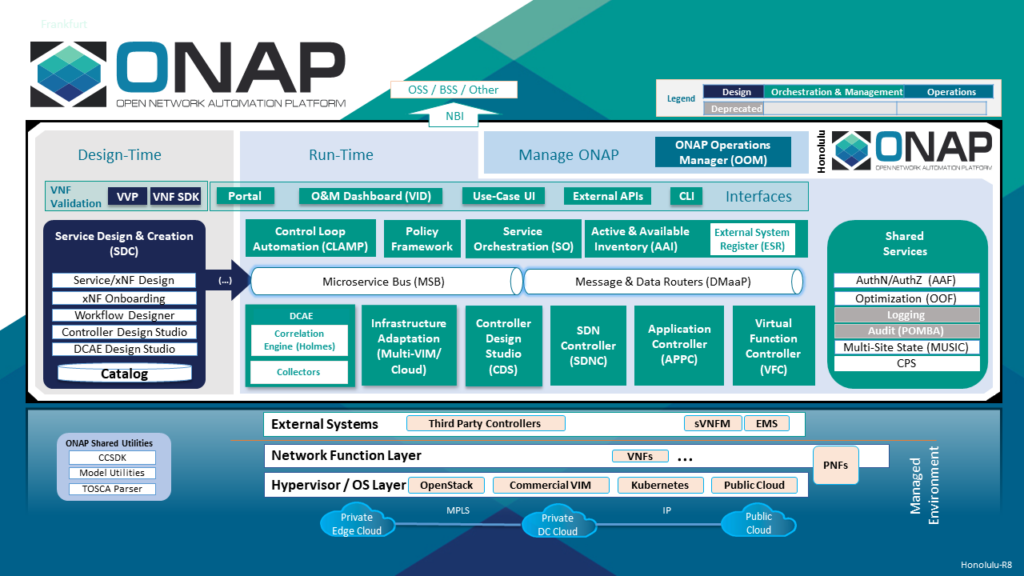ONAP Platform Architecture
The ONAP Platform enables product-independent capabilities for design, creation and lifecycle management of network services. ONAP uniquely provides a unified operating framework for vendor-agnostic, policy-driven service design, implementation, analytics and lifecycle management for large-scale workloads and services. With ONAP, network operators can synchronously orchestrate physical and virtual network functions. This approach allows operators to leverage existing network investments; at the same time, ONAP’s openness and ubiquitous acceptance by major network providers around the globe accelerates the development of a vibrant VNF ecosystem.
As part of each release, the ONAP community also defines blueprints for key use cases, such as 5G, BBS, CCVPN, Voice over LTE (VoLTE), and vCPE, which the user community expects to pursue immediately. Testing these blueprints with a variety of open source and commercial network elements during the development process provides the ONAP platform developers with real-time feedback on in-progress code, and ensures a trusted framework that can be rapidly adopted by other users of the final release.
Platform Architecture Diagram Honolulu Release

As a cloud-native application that consists of numerous services, ONAP requires sophisticated initial deployment as well as post-deployment management. The ONAP Operations Manager (OOM) is responsible for orchestrating the end-to-end lifecycle management and monitoring of ONAP components. It is integrated with the Microservices Bus, which provides service registration/discovery and support for internal and external APIs and key SDKs. OOM uses Kubernetes to provide CPU efficiency and platform deployment. In addition, OOM helps enhance ONAP platform maturity by providing scalability and resiliency enhancements to the components it manages.
The platform provides tooling for service designers as well as a model-driven run-time environment, with monitoring and analytics to support closed-loop automation and ongoing service optimization. Both design-time and run-time environments are accessed through the Portal Framework, with role-based access for service designers and operations personnel.
The design-time framework provides a comprehensive development environment with tools, techniques, and repositories for defining and describing resources, services, and products. This includes policy design and implementation, as well as an SDK with tools for VNF supplier packaging and validation.
The run-time environment executes the rules and policies distributed by the design and creation environment, as well as the Controllers that manage physical and virtual networks. The Active & Available Inventory (A&AI) component provides real-time views of a system’s resources, services, products and their relationships with each other. In a fast-moving environment with rapid deployment and teardown of virtual resources, this real-time monitoring and mapping is critical to service assurance.
The run-time service execution components are in constant communication with the closed-loop automation modules, which provide real-time monitoring, analytics, alarm and event correlation, etc. These modules, in turn, provide up-to-the-moment intelligence about existing services to service designers, who may see opportunities to fine tune them, or replicate high-performing portions of deployed services in creating new ones.
ONAP covers a wide range of use cases for Communication Service Providers (CSP) and the open source networking industry. Upon reaching a certain level of maturity, use cases become ONAP Blueprints.

